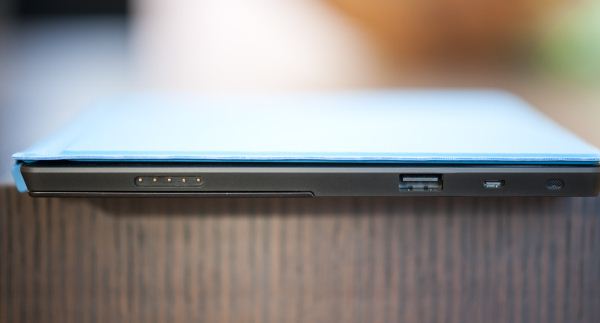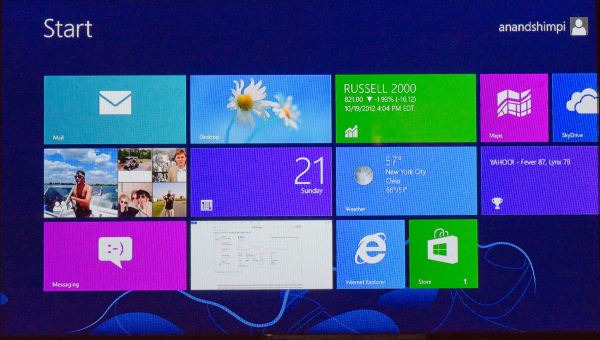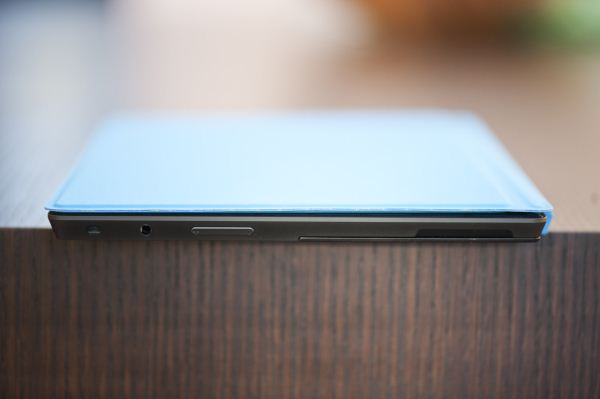Microsoft Surface Review
by Anand Lal Shimpi on October 23, 2012 9:01 PM EST- Posted in
- Tablets
- Microsoft
- Mobile
- Surface
- Windows RT
A Plethora of Ports and Storage Options
One area where Surface is a significant departure from the iPad is in its IO and expansion. The iPad features a single dock (and soon to be Lightning) connector, while Surface looks more like a laptop (or Android tablet) when it comes to IO.
There’s no port for syncing, you get content onto Surface via WiFi or a more traditional method. Surface has a single USB 2.0 port on the right side of the device. You can plug almost anything you want into this port, including USB storage devices of course. Behind the kickstand is a single microSD card slot, giving you another option for expansion.
On the left edge of the device there’s a micro-HDMI out port that can be paired with a Microsoft made VGA or HDMI dongle (both dongles have a 22-degree connector on them to mate flush with Surface). I tested HDMI output with Microsoft's dongle and unfortunately the result wasn't very good. The 1080p output had a lot of issues with scaling quality (as you can see from the shot below) and there was a lot of tearing on the screen with a big impact on UI frame rate. I reached out to Microsoft for an explanation but have yet to hear anything.
Finally there’s a standard 1/8” headphone jack along the top of the device.
Power delivery comes via a custom magnetic connector along the lower right side of Surface.
Given that the internal storage is an eMMC solution, performance from the microSD slot with a good card should be fairly comparable. In practice I could read and write a large sequential file at roughly 10.5 MB/s using a SanDisk microSD card.
Copying from a fast USB stick to Surface’s internal storage gave me transfer rates closer to 17MB/s. There are a few vendors for Windows 8/RT eMMC devices, I’ll be paying close attention over the coming weeks to figure out who makes the best. I know Microsoft and Intel (among others) have been playing close attention to the eMMC providers with hopes of weeding out those that deliver honestly unacceptable performance.
While doing background file IO I didn’t notice any of the stalling/pausing that we’ve seen on some of the more recent Android tablets.
Update: Many have asked about how much storage is taken up by the Windows + Office 2013 installs. The screenshot below shows the directory size for both C:\Windows and C:\Program Files, the latter is where the Office15 install files are included (and yes winword.exe is still the Word executable).
You're looking at roughly 6.47GB for Windows RT and then another 830MB for Office for a grand total of around 7.3GB.
USB Compatibility
Microsoft is particularly proud of its single USB 2.0 port on Surface. Although USB ports have been featured on several Android tablets, their support was typically limited to flash drives, keyboards and mice. With Windows RT, Microsoft wants to bring more of the traditional Windows experience to tablets. Had Surface been x86 based, you would be able to plug in virtually any USB peripheral and it would just work. As the first version of Surface is based on an ARM SoC, driver support is a little more limited but still pretty decent.
USB drives obviously work as you’d expect them to. Even SATA to USB adapters worked fine when plugged into Surface. Other smartphones and tablets also worked, although their level of support varied. For example, you can plug in the iPhone 5 and have it come up as a supported device for moving pictures to/from. However USB tethering is not supported by the class driver included in Windows RT. You can even plug an iPad into Surface and get the same level of support.
Printer support is pretty decent, although the Epson Workforce 910 I tried didn’t actually have specific driver support under RT. Although development for the desktop side of Windows is limited, manufacturers can supply Windows RT drivers to enable support for some more obscure devices. Unfortunately when it comes to those devices you’ll have to play the waiting game as there’s simply not a lot of third party Windows RT drivers available for download today.






_575px.png)








235 Comments
View All Comments
kyuu - Tuesday, October 23, 2012 - link
Agreed, I'd like some clarification on this as well. I certainly hope it's a simple micro-HDMI that can be used with off-the-shelf adapters.ervinshiznit - Tuesday, October 23, 2012 - link
Anand,You mention that you would have liked to have seen the surface with x86. Is Windows RT only compatible with ARM or does it support x86 also? I realize it's just a compilation issue but I was under the impression that only ARM builds of Windows RT would ever be released by Microsoft.
MadMan007 - Tuesday, October 23, 2012 - link
Don't connect the hardware branding name 'Surface' and software. You are correct that WinRT=ARM only. But there will be Microsoft Surface devices using x86 hardware running full Windows 8.Will there be a budget Atom-based x86 Surface, in the same form factor as this one? I'm not sure off the top of my head, but that's probably what Anand meant.
ervinshiznit - Tuesday, October 23, 2012 - link
There have only been plans announced for the Surface Pro, which would include a Core i5 and run full Windows 8.I bring up the Windows RT=ARM only because Anand brought up the performance issue in the context of MS Office, and he said that he would have liked to see an Atom in the Surface instead of this ARM core. But then it wouldn't be able to run RT. And that would also mean no free Office 2013 since it's not included in full Windows 8
Ryan Smith - Tuesday, October 23, 2012 - link
Whether or not to include Office is basically arbitrary. Microsoft could include it with Surface Pro, as it's entirely up to them..The point to take home is not that RT doesn't run on Atom, but rather that Office on Surface is currently unusually sluggish. A SoC with better performance in lightly threaded situations (such as the Atom) would handle Office better based on what we're seeing.
Kevin G - Wednesday, October 24, 2012 - link
Reading through this review and others seems to point the problem at Office being sluggish and not necessarily the Tegra 3. Even on the PC side where far higher performing hardware exists, Office doesn't give the impression of a speed champion. I'd love to see Office compared on the Surface, Surface Pro and a decent laptop. Yeah, the deck would stacked in favor of the laptop winning but it'd be a good reference point for users as well as reviewing the idea of usability on each device. For example, I can see the utility of viewing and making a quick and simple change to an Excel spread sheet on a tablet but for heavy Excel use restricted to an on screen touch keyboard would likely result in levels of frustration that'd have me snapping the tablet in two.kyuu - Thursday, October 25, 2012 - link
That's the reason for the Touch/Type Covers...ervinshiznit - Tuesday, October 23, 2012 - link
Anand,You say
Application launch times are another thing entirely. Nearly every application I launched took longer than I would’ve liked on Surface. I can’t tell if this is a hardware issue or a software optimization problem, but application launches on Surface/Windows RT clearly take more time than on an iPad. I timed a few just to put this in perspective:
And after the : I expected a chart or something but there's nothing there.
JumpingJack - Tuesday, October 23, 2012 - link
I asked the same question, Ryan said they were overwhelmed with the iPad announcement, the 8350 launch, and his... He said Anand will fill in he info a bit later.michal1980 - Wednesday, October 24, 2012 - link
apple products didn't get short changed reviews... I wonder why.